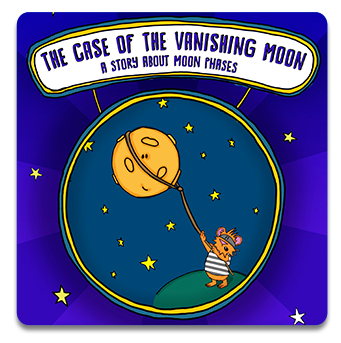You’ve maybe heard the poem “I Love You to the Moon and Back.” That certainly seems appropriate during this month of love, Cupid, and valentine cards. But what really excites us is thinking about getting to the Moon and back from a scientist’s perspective. Our Moon, rockets, and thrust command our attention during February.
The Moon is fascinating. In terms of distance, it is the closest heavenly body to Earth. We can see it in the sky for three weeks out of four, and people have used its light for thousands of years to guide them in the dark. This year, February 27 will be a full moon. This full moon was known by early Native American tribes as the Full Snow Moon because the heaviest snows usually fell during this time of the year.
From the ‘Man in the Moon’ to being made of cheese, there are all kinds of interesting legends and myths associated with the Moon and its cycles. In February we feature the Fuddlebrook story, The Case of the Vanishing Moon where the children and Herman Tweed learn about moon phases and help Freddie solve the mystery of why the Moon gets smaller and smaller. We also demonstrate “Herman’s Rocket Launch” to learn how thrust propels an object.
Is February cold where you are? According to measurements taken by NASA space probes, the coldest place in our solar system is on our very own Moon. It lies deep inside lunar craters, in places that never experience sunlight. The temperatures in these craters, which lie near the poles, approach about -238 C or -396 F.
February is also a month that, according to NASA, can never experience a "Blue Moon,” the name given to the second full moon in a calendar month. Because there are roughly 29.5 days between full moons, it is unusual for two full moons to "fit" into a 30 or 31 day month (and impossible to fit into a 28 or 29 day month).
How about some other fun science trivia about the Moon, too?
Gravity on the Moon is much less than on Earth. A person who weighs 180 pounds on Earth would weigh only 30 pounds on the Moon. It is for this reason that the astronauts could maneuver so easily on the lunar surface, despite all the massive equipment.
The Moon experiences extreme temperature shifts every couple weeks. Because it has no atmosphere and rotates so slowly, any particular surface patch on the Moon will experience wild temperature extremes, from a low of -272 degrees F (-168 C) to highs approaching 243 degrees F (117.2 C). As the lunar terrain experiences changes in light and darkness about every two weeks, there is no circulation of the heat as there is on Earth (thanks to wind and other atmospheric effects). So, the Moon is at the complete mercy of whether the Sun is overhead or not. The lack of atmosphere also means no sound can be heard on the Moon, and the sky always appears black.
The Moon has water. In the last two decades NASA has crashed a series of probes into the lunar surface to measure the amount of water in or beneath the rocks. What they found was surprising, there was much more H2O present than anyone had previously thought. In addition, there's evidence of water ice at the poles, hidden in craters that get no sunlight. In spite of these findings, the Moon’s surface is still dryer than the driest desert on Earth.
The Moon is drifting away from Earth. The Moon is moving approximately 3.8 cm away from our planet every year. It is estimated that it will continue to do so for around 50 billion years. By the time that happens, the Moon will be taking around 47 days to orbit the Earth instead of the current 27.3 days.
The Moon has only been walked on by 12 people; all American males. The first man to set foot on the Moon in 1969 was Neil Armstrong on the Apollo 11 mission, while the last man to walk on the Moon in 1972 was Gene Cernan on the Apollo 17 mission. Since then the Moon has only be visited by unmanned vehicles.
